More than 100 Amazon dolphins found dead as water temperatures reach 39C
David Millward
Mon, October 2, 2023
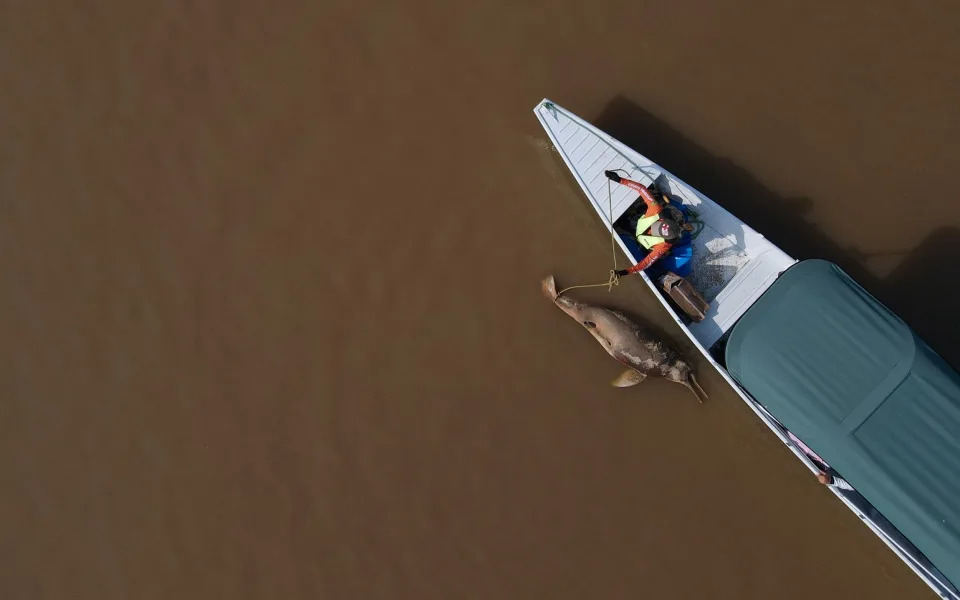
Scientific researchers find another dead dolphin floating on Lake Tefé in Brazil - Bruno Kelly/Reuters
More than 100 dead dolphins were discovered within a week in the Amazon rainforest after water temperatures soared to 39C (102F).
They were found in Lake Tefé, in Brazil, and scientists have attributed their deaths to an extreme heat and drought that has swept across the region.
The deaths were described as unusual by the Mamirauá Institute, which is funded by the Brazilian ministry of science.
“It’s still early to determine the cause of this extreme event but according to our experts, it is certainly connected to the drought period and high temperatures in Lake Tefé,” the institute told CNN.
Rescue mission
Experts are trying to save the surviving dolphins by shifting them to cooler lagoons.
“Transferring river dolphins to other rivers is not that safe because it’s important to verify if toxins or viruses are present [before releasing the animals into the wild],” said André Coelho, a researcher at the Mamiraua Institute.
The Amazon river dolphins, many of which have a striking pink colour, are unique freshwater species found only in the rivers of South America and are one of only a handful of freshwater dolphin species left in the world. Slow reproductive cycles make their populations especially vulnerable to threats.
At least 70 of the carcasses surfaced on Thursday when Lake Tefé‘s water became 10C higher than the average for this time of year.
“We have documented 120 carcasses in the last week,” said Miriam Marmontel, a researcher at the Mamirauá institute.

Researchers from the Mamiraua Institute retrieve a dead dolphin at Lake Tefé - BRUNO KELLY/reuters
The combination of high temperatures and drought has been wreaking havoc in the region.
Transport and fishing have been hit by below-average water levels reported in 59 municipalities in the Amazon region.
In some parts of the country, temperatures have topped 40C, with a scorching spring following on from the country’s warmest winter in more than 60 years.
Only last month, zookeepers in Rio de Janeiro fed ice lollies to black spider monkeys to keep them cool and lions were given frozen meat.
Forest fires swept through the Bahia region in north-eastern Brazil as the National Institute of Meteorology categorised the heatwave as a “great danger”.
Records broken
Records have been broken in Peru, Bolivia, Paraguay, Argentina, and Brazil, with experts attributing the soaring temperatures to a “heat dome”.
Earlier this year vast swathes of the US sweltered in scorching temperatures, especially in the West where records were broken in seven states.
According to the research group Climate Central, 98 per cent of the world’s population was exposed to extreme heat at least once between June and August of 2023.
“In every country we could analyse, including the Southern Hemisphere where this is the coolest time of year, we saw temperatures that would be difficult – and in some cases nearly impossible – without human-caused climate change,” said Andrew Pershing, the group’s vice-president of science.
David Millward
Mon, October 2, 2023

Scientific researchers find another dead dolphin floating on Lake Tefé in Brazil - Bruno Kelly/Reuters
More than 100 dead dolphins were discovered within a week in the Amazon rainforest after water temperatures soared to 39C (102F).
They were found in Lake Tefé, in Brazil, and scientists have attributed their deaths to an extreme heat and drought that has swept across the region.
The deaths were described as unusual by the Mamirauá Institute, which is funded by the Brazilian ministry of science.
“It’s still early to determine the cause of this extreme event but according to our experts, it is certainly connected to the drought period and high temperatures in Lake Tefé,” the institute told CNN.
Rescue mission
Experts are trying to save the surviving dolphins by shifting them to cooler lagoons.
“Transferring river dolphins to other rivers is not that safe because it’s important to verify if toxins or viruses are present [before releasing the animals into the wild],” said André Coelho, a researcher at the Mamiraua Institute.
The Amazon river dolphins, many of which have a striking pink colour, are unique freshwater species found only in the rivers of South America and are one of only a handful of freshwater dolphin species left in the world. Slow reproductive cycles make their populations especially vulnerable to threats.
At least 70 of the carcasses surfaced on Thursday when Lake Tefé‘s water became 10C higher than the average for this time of year.
“We have documented 120 carcasses in the last week,” said Miriam Marmontel, a researcher at the Mamirauá institute.

Researchers from the Mamiraua Institute retrieve a dead dolphin at Lake Tefé - BRUNO KELLY/reuters
The combination of high temperatures and drought has been wreaking havoc in the region.
Transport and fishing have been hit by below-average water levels reported in 59 municipalities in the Amazon region.
In some parts of the country, temperatures have topped 40C, with a scorching spring following on from the country’s warmest winter in more than 60 years.
Only last month, zookeepers in Rio de Janeiro fed ice lollies to black spider monkeys to keep them cool and lions were given frozen meat.
Forest fires swept through the Bahia region in north-eastern Brazil as the National Institute of Meteorology categorised the heatwave as a “great danger”.
Records broken
Records have been broken in Peru, Bolivia, Paraguay, Argentina, and Brazil, with experts attributing the soaring temperatures to a “heat dome”.
Earlier this year vast swathes of the US sweltered in scorching temperatures, especially in the West where records were broken in seven states.
According to the research group Climate Central, 98 per cent of the world’s population was exposed to extreme heat at least once between June and August of 2023.
“In every country we could analyse, including the Southern Hemisphere where this is the coolest time of year, we saw temperatures that would be difficult – and in some cases nearly impossible – without human-caused climate change,” said Andrew Pershing, the group’s vice-president of science.
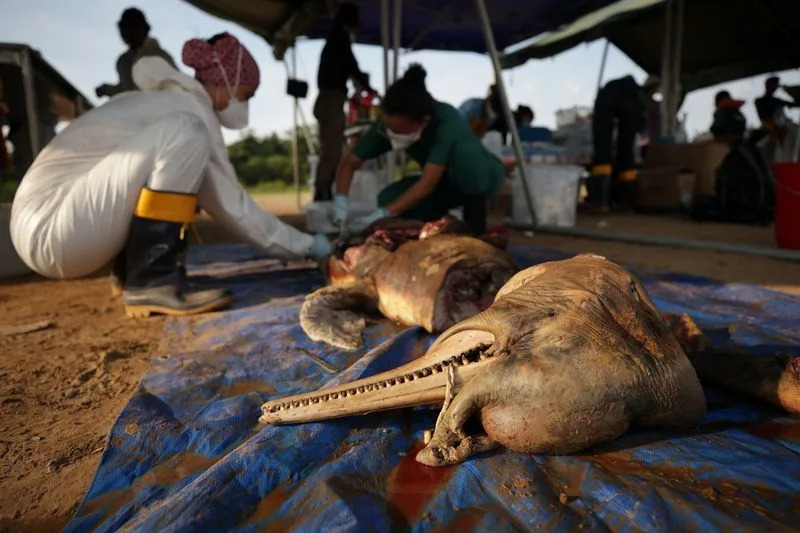
Dolphin was found dead at the Tefe lake affluent of the Solimoes river that has been affected by the high temperatures and drought in Tefe
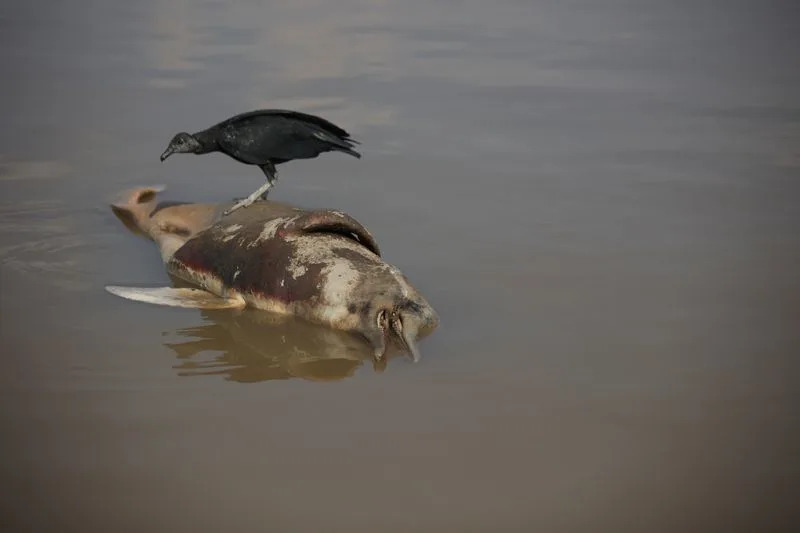
Dolphin was found dead at the Tefe lake, affluent of the Solimoes river that has been affected by the high temperatures and drought in Tefe
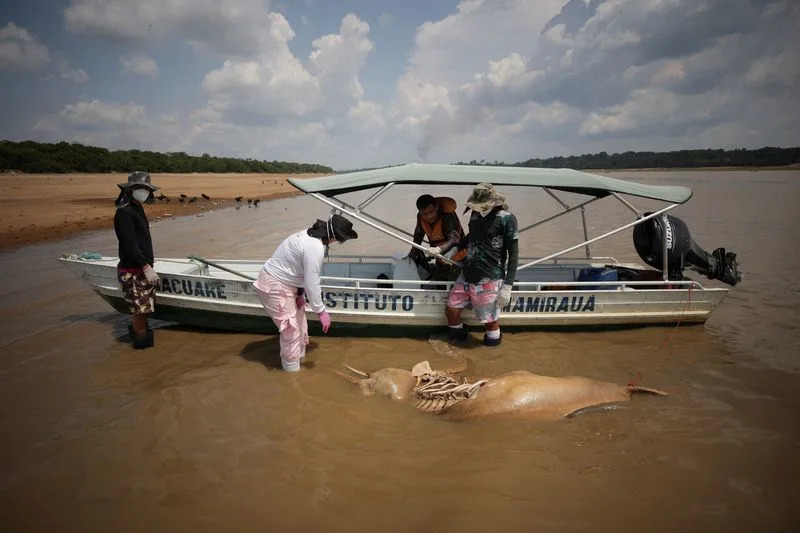
: Dolphin was found dead at the Tefe lake affluent of the Solimoes river that has been affected by the high temperatures and drought in Tefe
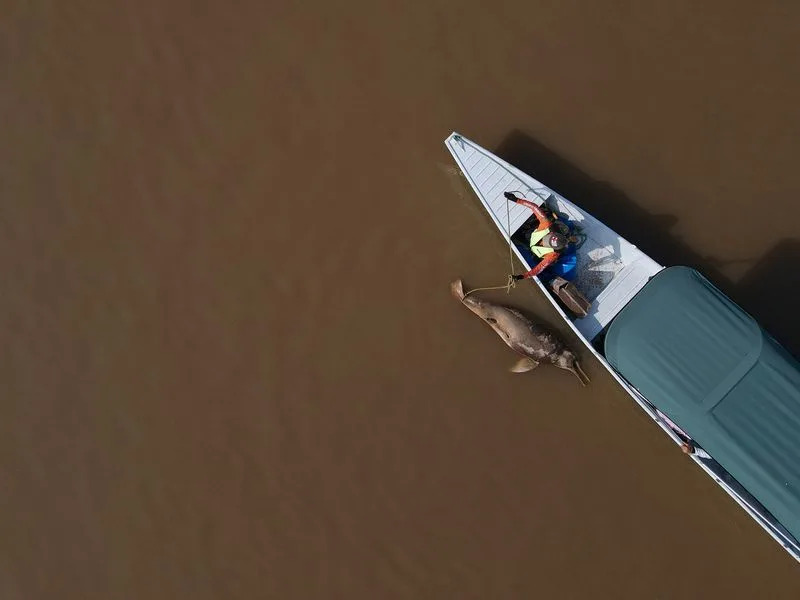
Dolphin was found dead at the Tefe lake, affluent of the Solimoes river that has been affected by the high temperatures and drought in Tefe
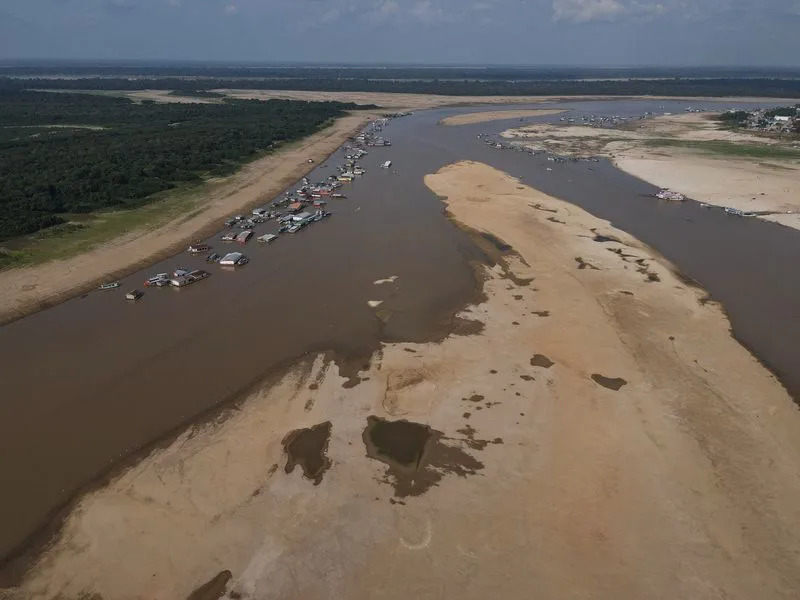
Dolphin was found dead at the Tefe lake affluent of the Solimoes river that has been affected by the high temperatures and drought in Tefe
Updated Mon, October 2, 2023
By Bruno Kelly
MANAUS (Reuters) - The carcasses of 120 river dolphins have been found floating on a tributary of the Amazon River since last week in circumstances that experts suspect were caused by severe drought and heat.
Low river levels during a severe drought have heated water in stretches to temperatures that are intolerable for the dolphins, researchers believe. Thousands of fish have died recently on Amazon rivers due to a lack of oxygen in the water.
The Amazon river dolphins, many of a striking pink color, are unique freshwater species found only in the rivers of South America and are one of a handful of freshwater dolphin species left in the world. Slow reproductive cycles make their populations especially vulnerable to threats.
Amid the stench of decomposing dolphins, biologists and other experts in white personal protective clothing and masks worked on Monday to conduct autopsies on each carcass to determine the cause of death.
The scientists do not know with total certainty that drought and heat are to blame for the spike in dolphin mortality. They are working to rule out other causes, such as a bacterial infection that could have killed the dolphins on a lake formed by the River Tefé before it runs into the Amazon.
At least 70 of the carcasses surfaced on Thursday when the temperature of Lake Tefé's water reached 39 degrees Celsius (102 degrees Fahrenheit), more than 10 degrees higher than the average for this time of the year.
The water temperature fell off for a few days but rose again on Sunday to 37 C (99 F), worried experts said.
Environmental activists have blamed the unusual conditions on climate change, which makes droughts and heat waves more likely. Global warming's role in the current Amazon drought is unclear, with other factors such as El Nino at play.
"We have documented 120 carcasses in the last week," said Miriam Marmontel, a researcher at the Mamirauá environmental institute that focuses on the mid-Solimões river basin.
She said roughly eight of every 10 carcasses are pink dolphins, called "botos" in Brazil, which could represent 10% of their estimated population in Lake Tefé.
The boto and the gray river dolphin called the "tucuxi" are on the International Union for Conservation of Nature's red list of threatened species
"10% is a very high percentage of loss, and the possibility that it will increase could threaten the survival of the species in Lake Tefé," Marmontel said.
Brazil's Chico Mendes Institute for Biodiversity Conservation (ICMBio) has rushed veterinarians and aquatic mammal experts to rescue dolphins that are still alive in the lake, but they cannot be moved to cooler river waters until researchers rule out a bacteriological cause of the deaths.
(Reporting by Bruno Kelly; Writing by Anthony Boadle; Editing by Brad Haynes and Jonathan Oatis)

Dolphin was found dead at the Tefe lake, affluent of the Solimoes river that has been affected by the high temperatures and drought in Tefe

: Dolphin was found dead at the Tefe lake affluent of the Solimoes river that has been affected by the high temperatures and drought in Tefe

Dolphin was found dead at the Tefe lake, affluent of the Solimoes river that has been affected by the high temperatures and drought in Tefe

Dolphin was found dead at the Tefe lake affluent of the Solimoes river that has been affected by the high temperatures and drought in Tefe
Updated Mon, October 2, 2023
By Bruno Kelly
MANAUS (Reuters) - The carcasses of 120 river dolphins have been found floating on a tributary of the Amazon River since last week in circumstances that experts suspect were caused by severe drought and heat.
Low river levels during a severe drought have heated water in stretches to temperatures that are intolerable for the dolphins, researchers believe. Thousands of fish have died recently on Amazon rivers due to a lack of oxygen in the water.
The Amazon river dolphins, many of a striking pink color, are unique freshwater species found only in the rivers of South America and are one of a handful of freshwater dolphin species left in the world. Slow reproductive cycles make their populations especially vulnerable to threats.
Amid the stench of decomposing dolphins, biologists and other experts in white personal protective clothing and masks worked on Monday to conduct autopsies on each carcass to determine the cause of death.
The scientists do not know with total certainty that drought and heat are to blame for the spike in dolphin mortality. They are working to rule out other causes, such as a bacterial infection that could have killed the dolphins on a lake formed by the River Tefé before it runs into the Amazon.
At least 70 of the carcasses surfaced on Thursday when the temperature of Lake Tefé's water reached 39 degrees Celsius (102 degrees Fahrenheit), more than 10 degrees higher than the average for this time of the year.
The water temperature fell off for a few days but rose again on Sunday to 37 C (99 F), worried experts said.
Environmental activists have blamed the unusual conditions on climate change, which makes droughts and heat waves more likely. Global warming's role in the current Amazon drought is unclear, with other factors such as El Nino at play.
"We have documented 120 carcasses in the last week," said Miriam Marmontel, a researcher at the Mamirauá environmental institute that focuses on the mid-Solimões river basin.
She said roughly eight of every 10 carcasses are pink dolphins, called "botos" in Brazil, which could represent 10% of their estimated population in Lake Tefé.
The boto and the gray river dolphin called the "tucuxi" are on the International Union for Conservation of Nature's red list of threatened species
"10% is a very high percentage of loss, and the possibility that it will increase could threaten the survival of the species in Lake Tefé," Marmontel said.
Brazil's Chico Mendes Institute for Biodiversity Conservation (ICMBio) has rushed veterinarians and aquatic mammal experts to rescue dolphins that are still alive in the lake, but they cannot be moved to cooler river waters until researchers rule out a bacteriological cause of the deaths.
(Reporting by Bruno Kelly; Writing by Anthony Boadle; Editing by Brad Haynes and Jonathan Oatis)
No comments:
Post a Comment